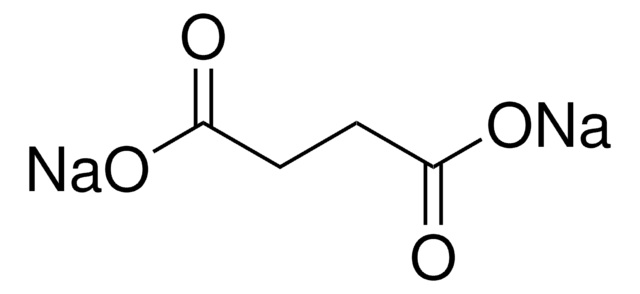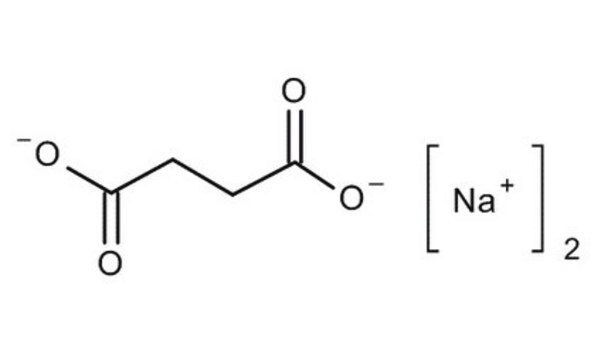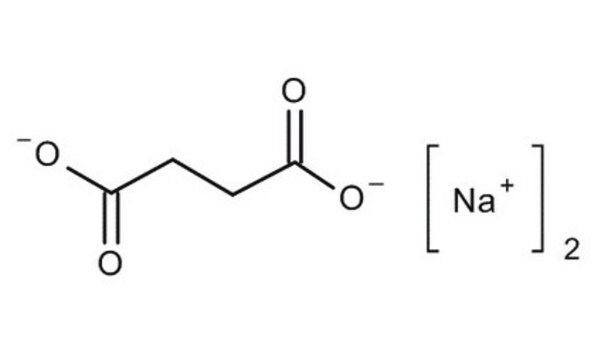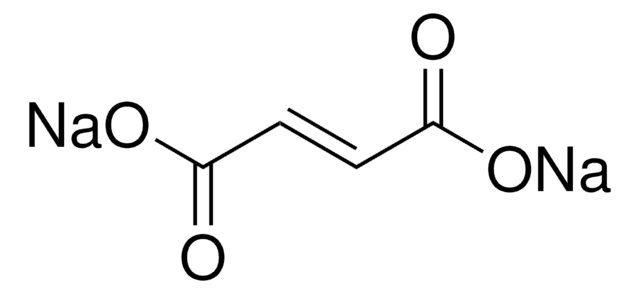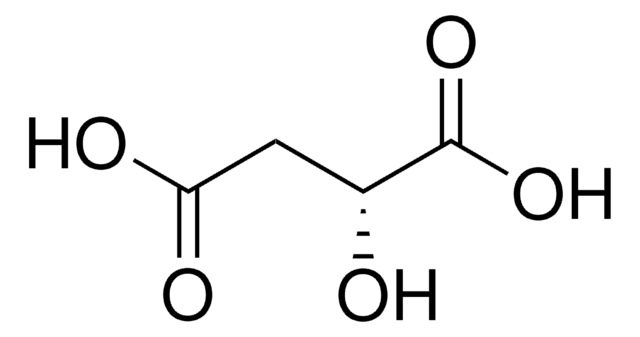W327700
Disodium succinate
≥98%
동의어(들):
Succinic acid disodium salt, Sodium succinate dibasic
로그인조직 및 계약 가격 보기
모든 사진(1)
About This Item
Linear Formula:
NaOOCCH2CH2COONa
CAS Number:
Molecular Weight:
162.05
FEMA Number:
3277
Beilstein:
3917246
EC Number:
MDL number:
UNSPSC 코드:
12164502
PubChem Substance ID:
플래비스(Flavis) 번호:
8.113
NACRES:
NA.21
추천 제품
생물학적 소스
synthetic
Grade
Halal
Kosher
규정 준수
FDA 21 CFR 117
분석
≥98%
응용 분야
flavors and fragrances
문건
see Safety & Documentation for available documents
식품 알레르기항원
no known allergens
감각 수용성의
odorless
SMILES string
[Na+].[Na+].[O-]C(=O)CCC([O-])=O
InChI
1S/C4H6O4.2Na/c5-3(6)1-2-4(7)8;;/h1-2H2,(H,5,6)(H,7,8);;/q;2*+1/p-2
InChI key
ZDQYSKICYIVCPN-UHFFFAOYSA-L
유사한 제품을 찾으십니까? 방문 제품 비교 안내
일반 설명
Disodium succinate is used in the food industry as an acidity regulator and flavor enhancer.
애플리케이션
- Application of Electronic Tongue in Umami Detection and Soy Sauce Refining Process.: Utilizing disodium succinate, this paper discusses the application of electronic tongue technology in detecting umami flavors and refining soy sauce, highlighting innovations in food chemistry and sensory evaluation methods (Zhang et al., 2023).
- Fabrication of Succinate-Alginate Xerogel Films for In Vitro Coupling of Osteogenesis and Neovascularization.: This research explores the creation of succinate-alginate xerogel films aimed at enhancing osteogenesis and neovascularization in vitro, pointing to significant developments in biomaterials for tissue engineering (Deering et al., 2022).
면책조항
For R&D or non-EU Food use. Not for retail sale.
Storage Class Code
11 - Combustible Solids
WGK
WGK 1
Flash Point (°F)
Not applicable
Flash Point (°C)
Not applicable
개인 보호 장비
dust mask type N95 (US), Eyeshields, Gloves
이미 열람한 고객
Fenaroli's Handbook of Flavor Ingredients, 485-485 null
Making succinate more successful.
Potera C.
Environmental Health Perspectives, 113(12), A832-A832 null
María Blanca Sánchez et al.
PloS one, 10(7), e0132816-e0132816 (2015-07-23)
Biocides are used without restriction for several purposes. As a consequence, large amounts of biocides are released without any control in the environment, a situation that can challenge the microbial population dynamics, including selection of antibiotic resistant bacteria. Previous work
Tomoaki Haraguchi et al.
Journal of agricultural and food chemistry, 62(24), 5589-5594 (2014-05-27)
This study demonstrated that 0.5% dietary rutin, ellagic acid, or curcumin markedly increased cecal succinate levels in rats fed a high-fat diet, whereas catechin, caffeic acid, and quercetin did not. Other organic acids were modestly or hardly affected by polyphenols.
Ayca Erdem et al.
Environmental science and pollution research international, 22(22), 17917-17924 (2015-07-15)
To better understand the potential impacts of metal oxide nanoparticles (NPs) on Gram(+) Bacillus subtilis and Gram(-) Escherichia coli (K12) bacteria, eight different nanosized titanium dioxide (TiO2) suspensions with five different concentrations were used. Water quality parameters (pH, temperature, and
Global Trade Item Number
| SKU | GTIN |
|---|---|
| W327700-1KG | |
| W327700-5KG-K | 4061834227656 |
| W327700-SAMPLE | |
| W327700-SAMPLE-K | 4061835566884 |
| W327700-10KG | |
| W327700-10KG-K | 4061834227649 |
| W327700-1KG-K | 4061835566877 |
| W327700-5KG |
자사의 과학자팀은 생명 과학, 재료 과학, 화학 합성, 크로마토그래피, 분석 및 기타 많은 영역을 포함한 모든 과학 분야에 경험이 있습니다..
고객지원팀으로 연락바랍니다.